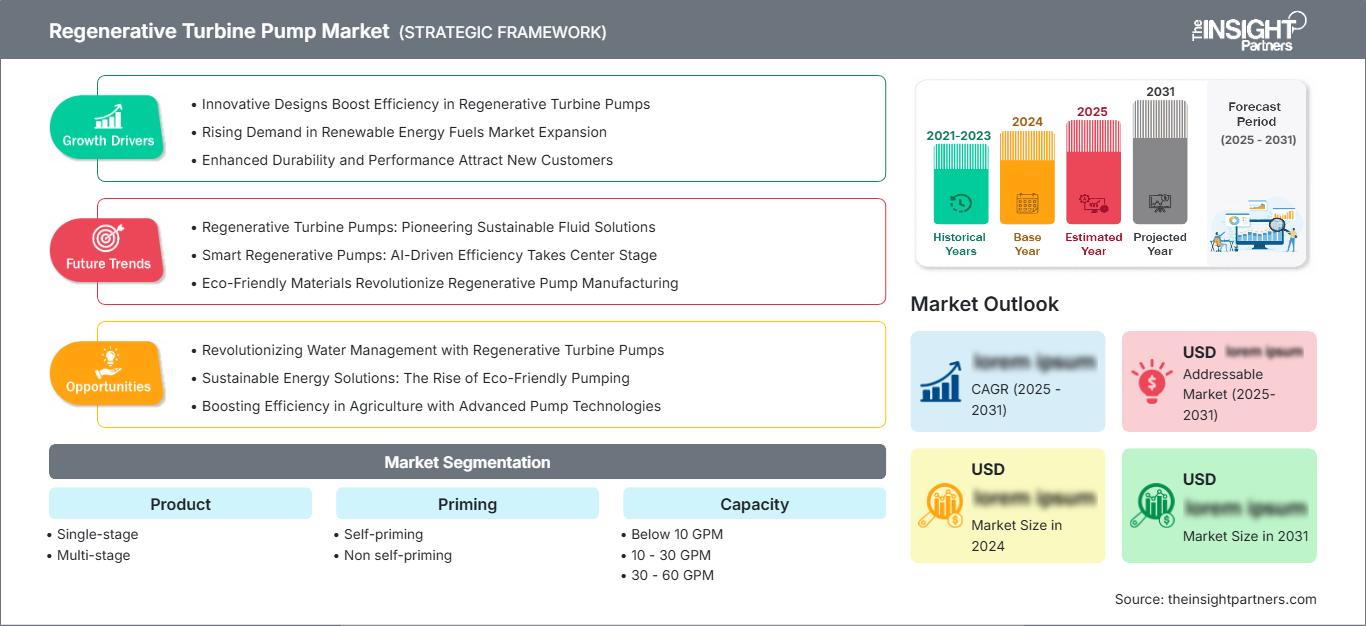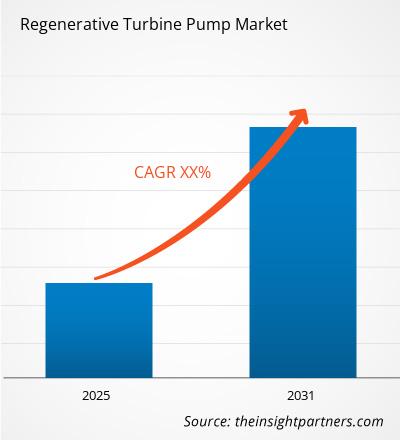Si prevede che il mercato delle pompe a turbina rigenerativa registrerà una crescita costante dal 2026 al 2034, con una valutazione prevista in crescita rispetto al valore di riferimento del 2025 e in un'espansione sostenuta fino alla fine del periodo di previsione. Questa tendenza riflette una prospettiva di mercato favorevole, guidata dall'evoluzione dei requisiti del settore e dai continui progressi tecnologici.
Il rapporto è suddiviso per prodotto (monostadio, multistadio) e analizza ulteriormente il mercato in base al tipo di adescamento (autoadescante, non autoadescante). Esamina inoltre il mercato in base alla capacità (inferiore a 10 GPM, 10-30 GPM, 30-60 GPM, superiore a 60 GPM) e all'applicazione industriale (agricoltura, prodotti chimici, edilizia e costruzioni, acqua e acque reflue, industria, petrolio e gas). Per ciascuno di questi segmenti chiave viene fornita una ripartizione completa a livello globale, regionale e nazionale. Il rapporto include le dimensioni del mercato e le previsioni per tutti i segmenti, presentando i valori in USD. Fornisce inoltre statistiche chiave sullo stato attuale del mercato dei principali attori, insieme ad approfondimenti sulle tendenze prevalenti e sulle opportunità emergenti.
Scopo del rapporto
Il rapporto "Regenerative Turbine Pump Market" di The Insight Partners mira a descrivere il panorama attuale e la crescita futura, i principali fattori trainanti, le sfide e le opportunità. Ciò fornirà spunti a vari stakeholder aziendali, come:
- Fornitori/Produttori di tecnologia: per comprendere le dinamiche di mercato in evoluzione e conoscere le potenziali opportunità di crescita, consentendo loro di prendere decisioni strategiche informate.
- Investitori: per condurre un'analisi completa delle tendenze in merito al tasso di crescita del mercato, alle proiezioni finanziarie di mercato e alle opportunità esistenti lungo la catena del valore.
- Enti di regolamentazione: per regolamentare le politiche e le attività di controllo sul mercato con l'obiettivo di ridurre al minimo gli abusi, preservare la fiducia degli investitori e sostenere l'integrità e la stabilità del mercato.
Segmentazione del mercato delle pompe a turbina rigenerativa Prodotto
- Monofase
- Multistadio
Adescamento
- Autoadescante
- Non autoadescante
Capacità
- Inferiore a 10 GPM
- 10 - 30 GPM
- 30 - 60 GPM
- Superiore a 60 GPM
Applicazione
- Agricoltura
- Prodotti chimici
- Edilizia e costruzioni
- Acqua e acque reflue
- Industriale
- Petrolio e gas
Potrai personalizzare gratuitamente qualsiasi rapporto, comprese parti di questo rapporto, o analisi a livello di paese, pacchetto dati Excel, oltre a usufruire di grandi offerte e sconti per start-up e università
Mercato delle pompe a turbina rigenerativa: Approfondimenti strategici

-
Ottieni le principali tendenze chiave del mercato di questo rapporto.Questo campione GRATUITO includerà l'analisi dei dati, che vanno dalle tendenze di mercato alle stime e alle previsioni.
Fattori di crescita del mercato delle pompe a turbina rigenerativa
- Progetti innovativi aumentano l'efficienza delle pompe a turbina rigenerativa
- Crescente domanda di espansione del mercato dei carburanti per energie rinnovabili
- Durata e prestazioni migliorate attraggono nuovi clienti
Tendenze future del mercato delle pompe a turbina rigenerativa
- Pompe a turbina rigenerativa: soluzioni innovative per fluidi sostenibili
- Pompe rigenerative intelligenti: l'efficienza basata sull'intelligenza artificiale è al centro dell'attenzione
- I materiali ecocompatibili rivoluzionano la produzione di pompe rigenerative
Opportunità di mercato per le pompe a turbina rigenerativa
- Rivoluzionare la gestione dell'acqua con le pompe a turbina rigenerativa
- Soluzioni energetiche sostenibili: l'ascesa del pompaggio ecologico
- Aumentare l'efficienza in agricoltura con tecnologie di pompaggio avanzate
Mercato delle pompe a turbina rigenerativa
Le tendenze regionali e i fattori che influenzano il mercato delle pompe a turbina rigenerativa durante il periodo di previsione sono stati ampiamente spiegati dagli analisti di The Insight Partners. Questa sezione illustra anche i segmenti e la geografia del mercato della gestione delle malattie del ritmo cardiaco in Nord America, Europa, Asia-Pacifico, Medio Oriente e Africa, America meridionale e centrale.
Mercato delle pompe a turbina rigenerativa Report Scope
| Attributo del rapporto | Dettagli |
|---|---|
| Dimensioni del mercato in 2025 | US$ XX Million |
| Dimensioni del mercato per 2034 | US$ XX Million |
| CAGR globale (2026 - 2034) | XX% |
| Dati storici | 2021-2024 |
| Periodo di previsione | 2026-2034 |
| Segmenti coperti |
By Prodotto
|
| Regioni e paesi coperti |
Nord America
|
| Leader di mercato e profili aziendali chiave |
|
Densità degli operatori del mercato delle pompe a turbina rigenerativa: comprendere il suo impatto sulle dinamiche aziendali
Il mercato delle pompe a turbina rigenerativa è in rapida crescita, trainato dalla crescente domanda degli utenti finali, dovuta a fattori quali l'evoluzione delle preferenze dei consumatori, i progressi tecnologici e una maggiore consapevolezza dei vantaggi del prodotto. Con l'aumento della domanda, le aziende stanno ampliando la propria offerta, innovando per soddisfare le esigenze dei consumatori e sfruttando le tendenze emergenti, alimentando ulteriormente la crescita del mercato.

- Ottieni il Mercato delle pompe a turbina rigenerativa Panoramica dei principali attori chiave
Punti di forza
- Copertura completa: il rapporto copre in modo completo l'analisi di prodotti, servizi, tipologie e utenti finali del mercato delle pompe a turbina rigenerativa, fornendo un panorama olistico.
- Analisi degli esperti: il rapporto è compilato sulla base della conoscenza approfondita di esperti e analisti del settore.
- Informazioni aggiornate: il rapporto garantisce rilevanza aziendale grazie alla sua copertura di informazioni recenti e tendenze dei dati.
- Opzioni di personalizzazione: questo rapporto può essere personalizzato per soddisfare le esigenze specifiche del cliente e adattarsi in modo appropriato alle strategie aziendali.
Il rapporto di ricerca sul mercato delle pompe a turbina rigenerativa può, quindi, aiutare a guidare il percorso di decodificazione e comprensione dello scenario del settore e delle prospettive di crescita. Sebbene possano esserci alcune preoccupazioni valide, i vantaggi complessivi di questo rapporto tendono a superare gli svantaggi.
- Analisi storica (2 anni), anno base, previsione (7 anni) con CAGR
- Analisi PEST e SWOT
- Valore/volume delle dimensioni del mercato - Globale, Regionale, Nazionale
- Industria e panorama competitivo
- Set di dati Excel
Report recenti
Rapporti correlati
Testimonianze
Motivo dell'acquisto
- Processo decisionale informato
- Comprensione delle dinamiche di mercato
- Analisi competitiva
- Analisi dei clienti
- Previsioni di mercato
- Mitigazione del rischio
- Pianificazione strategica
- Giustificazione degli investimenti
- Identificazione dei mercati emergenti
- Miglioramento delle strategie di marketing
- Aumento dell'efficienza operativa
- Allineamento alle tendenze normative






















 Ottieni un campione gratuito per - Mercato delle pompe a turbina rigenerativa
Ottieni un campione gratuito per - Mercato delle pompe a turbina rigenerativa